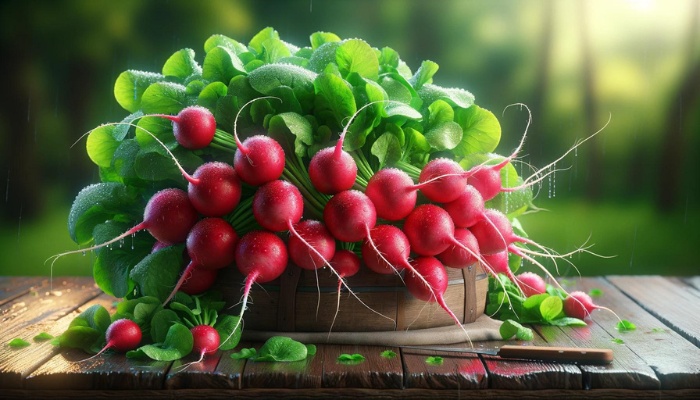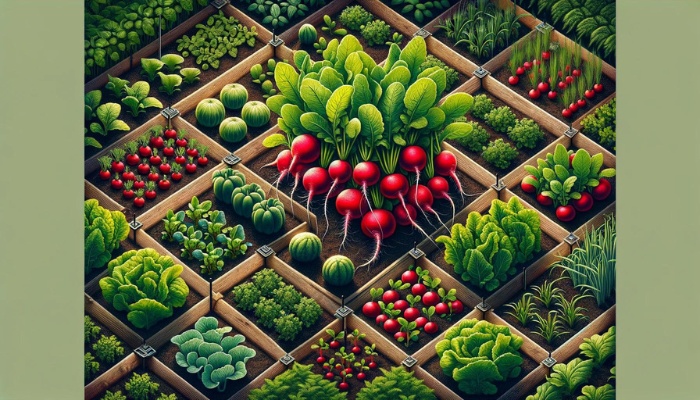Growing radishes in your square foot garden is like tending a miniature forest where each plant strives for its place under the sun.
You’ve got to prepare the soil just right, ensuring it’s loose and fertile for those quick-growing roots.
Planting them strategically allows for maximum growth without overcrowding, and a regular watering schedule keeps them plump and spicy.
However, your radishes face threats from pests and diseases, and knowing how to shield them effectively can make or break your harvest.
Optimal Soil Preparation
Before planting radishes in your square foot garden, you need to prepare the soil meticulously, ensuring it’s loose, fertile, and rich in organic matter for optimal root development.
Achieving the right soil pH is fundamental. Radishes thrive in a slightly acidic to neutral environment, ideally between 6.0 and 7.0.
You’ll want to conduct a soil test to determine the current pH level. If it’s outside the desired range, you can adjust it by adding elemental sulfur to decrease the pH or lime to increase it, depending on your specific needs.
Incorporating compost is another vital step in preparing your garden’s soil. Adding compost not only enriches the soil with essential nutrients but also improves its structure and water retention capabilities.
A well-composted soil supports the healthy growth of radish roots, ensuring they develop fully and evenly. Aim to mix in a generous amount of compost, about 2 to 4 inches, evenly into the top 6 to 8 inches of soil.
This creates an ideal environment for radishes to flourish, providing them with the necessary nutrients and moisture they require for rapid growth.
Planting Strategies
To maximize your harvest, carefully plan the spacing and depth when planting radishes in your square foot garden.
Understanding the needs of different radish varieties and adhering to precise spacing guidelines are essential for optimizing growth conditions and ensuring a bountiful yield.
Here are three strategic planting tips:
- Choose the Right Variety: Different radish varieties thrive under specific conditions. Some varieties, like ‘Cherry Belle’, are ideal for tight spaces due to their small size, while ‘Daikon’ radishes require more room to grow. Select varieties that best match your garden’s space and environmental conditions.
- Follow Spacing Guidelines: To prevent overcrowding and promote uniform growth, adhere to spacing guidelines. Generally, planting radishes 1 inch apart and thinning them to 2 inches apart once they’ve sprouted ensures each plant has enough space to develop. This spacing allows for optimal air circulation and nutrient absorption.
- Plant at the Correct Depth: Planting radishes at the right depth is essential for successful germination. Seeds should be sown about ½ inch deep. This depth provides the seeds with enough soil coverage to retain moisture while still allowing for easy emergence of seedlings.
Regular Watering Schedule

Maintaining a consistent watering schedule is crucial for the development of radishes as irregular moisture levels can lead to suboptimal growth and a compromised harvest.
Radishes thrive in soil that remains evenly moist but not waterlogged. Overwatering or underwatering can disrupt their delicate root systems, leading to poor development or splitting roots.
Implementing water conservation techniques and efficient irrigation systems can significantly enhance your radish crop’s quality and yield.
- Water every 1-2 days in the early morning
- Adjust the watering schedule as needed to account for rainfall
- Check soil moisture before watering
- Use drip irrigation to reduce evaporation
- Mulch to retain moisture
Pest and Disease Control
Monitoring your radish garden for pests and diseases ensures a healthy and bountiful harvest. Effective pest and disease control hinges on adopting a proactive and scientific approach, integrating principles of ecology and companion planting.
Here are three key strategies:
- Introduce Radish Companions: Cultivating radish alongside specific companions can significantly deter pests. For instance, planting chervil and nasturtiums among your radishes can repel aphids and various beetles, leveraging their natural repellent properties without resorting to harsh chemicals.
- Employ Natural Repellents: Garlic and onion plants, when interspersed within the radish bed, act as potent natural repellents. Their strong scents mask the radishes from pests like root maggots and flea beetles, effectively reducing infestation risks. This method aligns with the principles of permaculture, promoting a healthy, self-regulating garden ecosystem.
- Regular Monitoring and Manual Intervention: Diligently inspecting your radishes for signs of pests and diseases enables early detection and management. Hand-picking larger pests or using a soap spray for aphids can be remarkably effective when done consistently.
Implementing these strategies not only enhances your radish yield but also fosters a resilient and ecologically balanced garden environment.
Harvesting Techniques
After ensuring your radish garden is well-protected against pests and diseases, focus on the appropriate harvesting techniques to maximize your yield.
Understanding the specific needs and growth rates of different radish varieties is key to determining the optimal harvest timing.
Each variety has a unique growth cycle, and missing the ideal harvest window can lead to overly pungent tastes or woody textures.
To master the harvesting process, you’ll need to monitor your radishes closely as they approach maturity. Most radish varieties are ready for harvest approximately 3-4 weeks after planting, but this can vary.
The root should be firm and the surface smooth, indicating they’re at peak crispness and flavor.
Gently loosen the soil around the radish to check its size without disturbing the root. This precision avoids unnecessary stress on the plant, ensuring the remaining radishes continue to develop undisturbed.
When you’ve confirmed it’s the right time, grasp the radish greens near the base and pull straight up with a steady motion to remove the radish from the soil.

